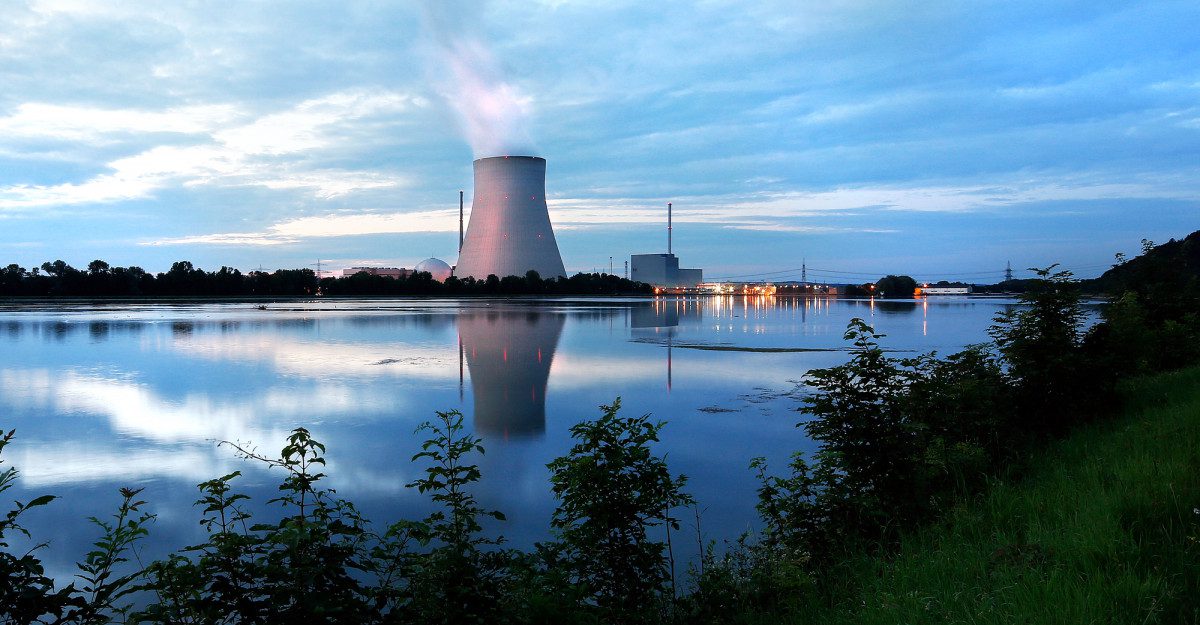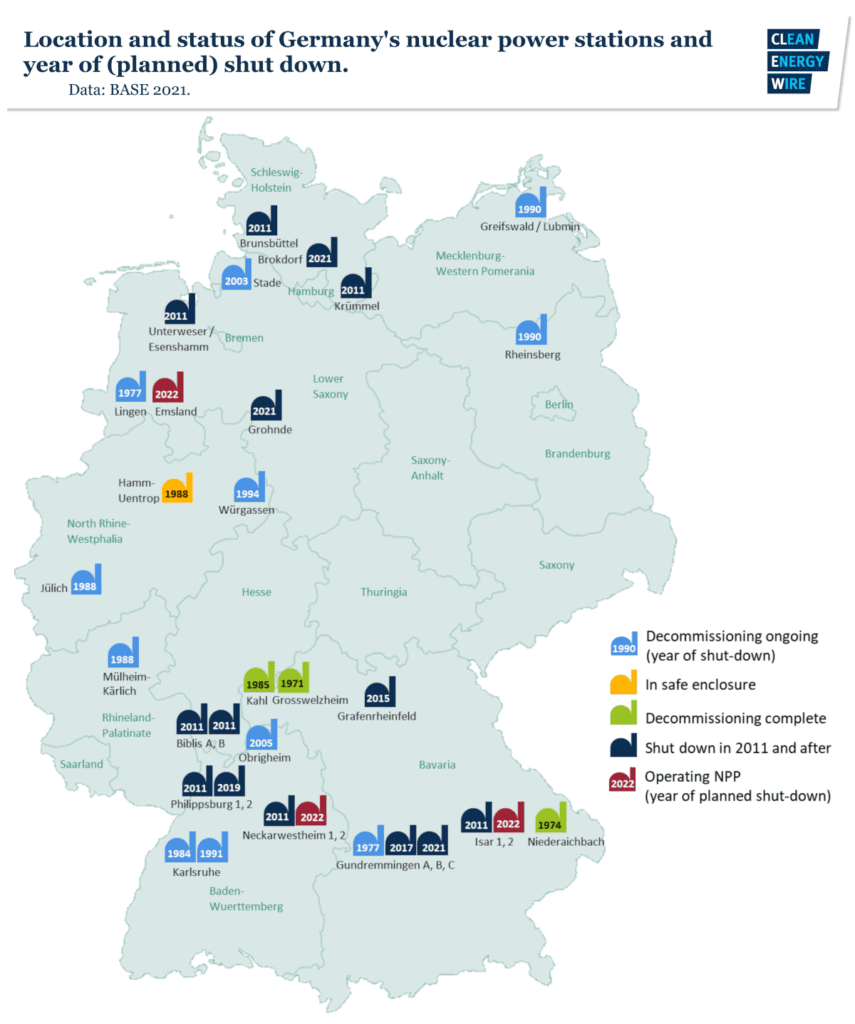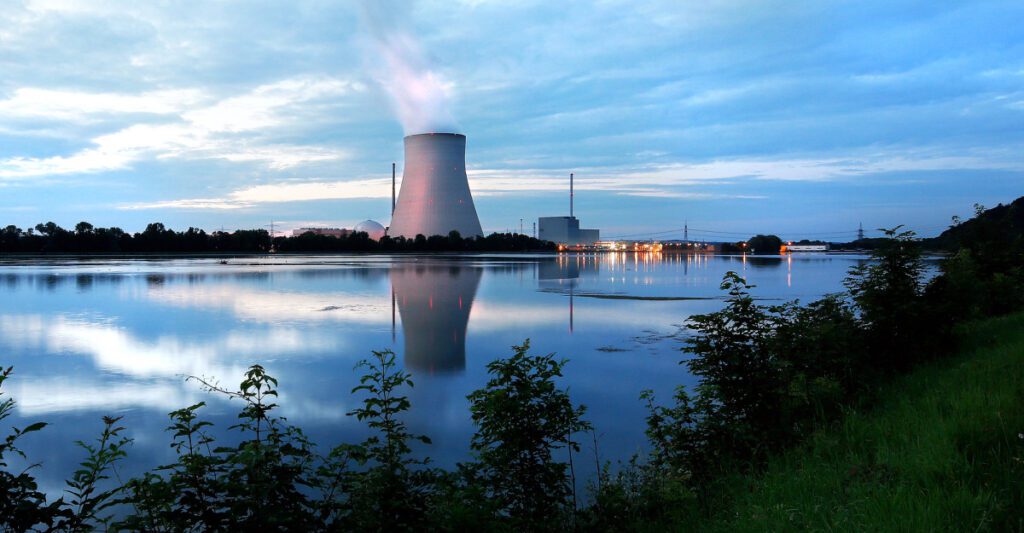Germany Halts Closure of Two Nuclear Plants Until April 2023
Credit to Author: Sonal Patel| Date: Thu, 08 Sep 2022 19:12:22 +0000

Germany plans to keep two of its three last nuclear power plants on standby until mid-2023—beyond their year-end closure deadline—to bolster its energy security through the winter. However, the declaration has prompted confusion within Germany’s nuclear industry, which says nuclear plants aren’t suited to perform as operating reserve.
Germany’s Federal Ministry for Economic Affairs and Climate Action (BMWK) on Sept. 5 said it created a nuclear power plant deployment reserve that will keep the 1.4-GWe Isar 2 in Bavaria and the 1.3-GWe Neckarwestheim 2 in Baden Württemberg “available” until mid-April 2023 so they can contribute to the power grid in southern Germany over winter 2022/2023 if necessary. However, all of Germany’s remaining reactors, Isar 2, Neckarwestheim 2, and the 1.4-GWe Emsland—a combined 4.3 GW—will be taken off the grid as planned in December 2022 to comply with Germany’s Atomic Energy Act.
German Chancellor Olaf Scholz on Sept. 7 crushed calls for the government to commit to a longer-term extension of the nuclear plants and diverge from Germany’s 2011-instituted accelerated nuclear exit in the wake of the Fukushima disaster. The country in December 2021 began shuttering its 9.5-GW nuclear fleet at the end of 2021 with the closure of Brokdorf, Grohnde, and Gundremmingen C—a combined 4.2 GW.

A Summer Marked by Energy Disruptions
BMWK’s plan unveiled on Monday follows a fierce debate about the future of Germany’s existing nuclear plants as the country grapples with an intensifying energy crisis, prompted in part by a decline in Russian gas deliveries, and ambitious climate goals. Berlin has this year so far conducted three evaluations that have assessed its energy adequacy, including exploring how nuclear power could fit into its energy plans over the short- and long-term.
In March—while Russia was two weeks into its large-scale invasion of Ukraine—BMWK released the results of a review that explored whether it was feasible to keep Germany’s existing nuclear plants operating longer than planned. The review outlined several substantial legal, regulatory, and technical hurdles to keeping the plants open, or reopening shuttered plants. Between March and May 2022, BMWK and four German transmission operators—50Hertz, Amprion, TenneT, and Transnet BW—carried out a special analysis of Germany’s grid conditions given new and emerging constraints. That first so-called “stress test” released in July concluded that “safe operation of the electricity supply network is guaranteed in the winter of 2022/23.”
New complexities over summer 2022, however, prompted Germany to reevaluate its grid security in a second stress test. The country’s energy security predicament has grown ever more intense since Russia on July 11 halted all flows on Nord Stream 1—the biggest single pipeline into Europe from Russia. While Germany, which relies on Russia for 55% of its gas deliveries, scrambled to boost its gas storage levels, it arranged for at least 8.5 GW of brown, hard coal-fired, and a small amount of oil-fired generation capacity to be able to continue operating to provide electricity on demand. Over the summer, it also suffered a dramatic drought, low water in rivers, and new import supply uncertainties stemming from the failure of half the French nuclear fleet.
What the Second Stress Test Showed
Economy Minister and Vice Chancellor Robert Habeck on Monday unveiled the results of the second stress test, which sought to identify bottlenecks in the grid. Conducted over a six-week period by Germany’s four transmission operators, the test concluded that hourly crisis situations in the electricity system in winter 22/23 are very unlikely, but “they cannot be completely ruled out,” BMWK said.
The stress test lays out three scenarios: a “critical” scenario, a “very critical” scenario, and an “extreme” scenario. The results suggest that grid bottlenecks will exist for all three scenarios, owing to a delayed grid expansion and a lack of generation capacity in the South. The extreme scenario assumes a fraction of French nuclear power will be available, half of Germany’s reserve capacity will not be operational, and half of Germany’s gas power fleet in the South will be unavailable.
“In Germany, we have a very high security of supply in the electricity system. We have enough energy in and for Germany; we are an electricity exporting country. But we are part of a European system and this year is a special year across Europe,” Habeck said on Monday.
“The Russian attack on Ukraine has created a tense situation in the energy markets, and we are doing everything we can to avoid a gas shortage. Around half of the nuclear power plants in France are currently failing. The summer drought has reduced the water levels in rivers and lakes, which weakens hydroelectric power in neighboring countries and also makes it difficult for us to transport coal to the power plants that we have to use due to the tight gas situation. And the expansion of renewable energies and the expansion of the power grid have slowed down significantly in recent years, which is having a particularly negative impact in the south of our country,” he explained. “Because of all these risks, we cannot be sure that in the event of grid bottlenecks in our neighboring countries there will be enough power plants available to help stabilize our electricity grid in the short term,” he said.
To guarantee no load shortages or power failures will occur in the upcoming winter, the government will continue returning coal plants to the market, work to improve transmission capacities, and increase its gas import capacity via floating liquefied natural gas (LNG) terminals. The government also plans to increase the availability of power from biogas plants and renewables.
The government’s newly created “nuclear deployment reserve,” which will include its two remaining southern nuclear plants, Isar 2 and Neckarwestheim, will also be important, although only in the “very critical” scenario. The stress test results suggest that keeping the three nuclear power plants available would only make “a limited contribution” during a stressful situation. “Overall, nuclear energy plays a subordinate role compared to the other urgent measures to ensure grid security in critical situations,” BMWK said. “Even if the three remaining nuclear power plants are used, significant interventions in the power plant market will still be necessary in order to ensure grid security.” That’s why the government opted for a “targeted” operational reserve that includes only the two southern nuclear plants and imposes a tight operational timeframe through mid-April 2023, BMWK said.
And that’s why Emsland in northern Germany did not qualify. “For northern Germany, on the other hand, other, less risky instruments can be used. Additional oil-fired power stations in the form of power station ships, so-called ‘power barges,’ can be deployed here at short notice. These are not available for Isar 2 and Neckarwestheim,” the agency said.
Habeck on Monday, meanwhile, underscored that the two nuclear plants will be utilized only if “the worst comes to the worst.” However, the long-term operation of the plants would not be an option, he suggested. “New fuel elements will not be loaded, and in mid-April 2023 the reserve will also be closed,” he said. “Nuclear power is and will remain a high-risk technology, and the highly radioactive waste will burden tens of generations to come. You can’t play with nuclear power. A blanket lifetime extension would therefore also not be justifiable with regard to the safety status of the nuclear power plants. With the operational reserve, we take into account the risks of nuclear technology and the special situation in winter 22/23,” he said.
Nuclear Industry Expresses Confusion
Government documents issued on Monday outline key conditions for operating the nuclear reserve. “The design of the operational reserve will take into account the necessary technical requirements of nuclear power,” BMWK noted. While the reserve will be regulated under the 1973-enacted Energy Security Act, the design “presupposes that no compromises are made on the usual security requirements. Accordingly, a reliable check of the security status is necessary,” the agency said.
BMWK additionally envisions that the Federal Network Agency, Germany’s federal power and gas regulator, will determine when power from the plants will be needed. The Federal Network Agency “should make the recommendation for calling up the reserve if the worst comes to the worst; the decision should then be made via a government ordinance with the possibility of objection by the Bundestag [Germany’s federal parliament]. The responsible nuclear regulatory authority issues the restart permit,” BMWK proposed.
BMWK’s plan to run the nuclear plants as operating reserves, however, has prompted confusion within Germany’s nuclear industry. On Sept. 7, E.ON, a German utility that operates Isar 2 through an affiliate, PreussenElekt, said it communicated to the German government that “nuclear power plants are not suitable for reserve power plant operation for technical reasons.” Reuters on Wednesday reported that EnBW, which operates Neckarwestheim 2 was also clarifying details on the ministry’s plan.

Germany’s nuclear business and technology association KernD, too, expressed “a lack of understanding” on the operational reserve, which it said “does not appear to be very practical.” The group added: “A short-term reaction to unfavorable weather conditions, for example, is therefore not—or hardly—possible from the point of view of the association. The association therefore urgently advises having the proposal revised and finding a more appropriate regulation.”
BMWK reportedly told Reuters that nuclear plant operators misunderstood that the plan called for flexible, load-following operation of the nuclear plants. Reuters cited a letter, which it claimed it had seen, in which Energy state secretary Patrick Graichen reportedly told E.ON that one or both reactors could remain in operation in December, or be restarted in January or February if deemed necessary.
Asked for a response, a KernD spokesperson told POWER that the details alleged in Graichen’s letter weren’t included in BMWK’s press conference, its press release, or list of frequently asked questions released on Monday. “What was mentioned by the ministry were terms like emergency operation and reserve,” the spokesperson said. “Given this intention, the proposed, very cumbersome procedure on eventually activating the plants makes any quick reaction impossible—and is thus not practical for a possible emergency. There are also technical limitations on how fast to bring up a nuclear power plant from the state of cold shut down, particularly under the condition of reduced reactivity in [an extended] operation.”
—Sonal Patel is a POWER senior associate editor (@sonalcpatel, @POWERmagazine).
The post Germany Halts Closure of Two Nuclear Plants Until April 2023 appeared first on POWER Magazine.